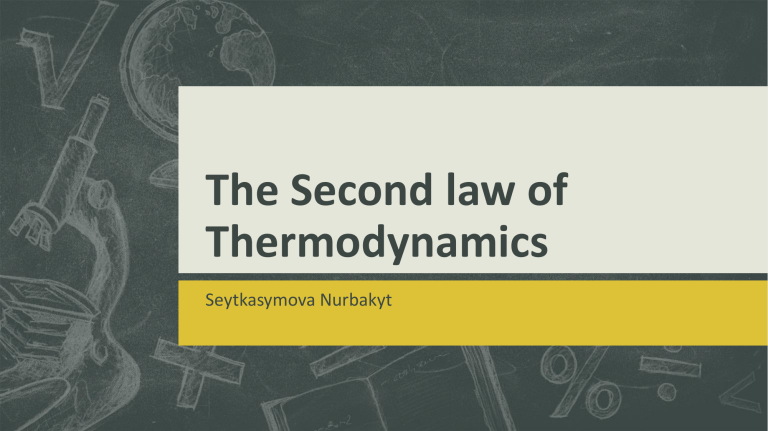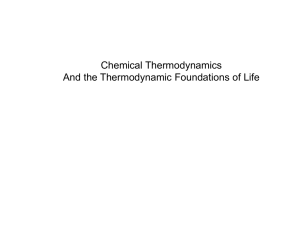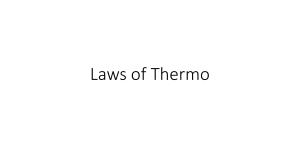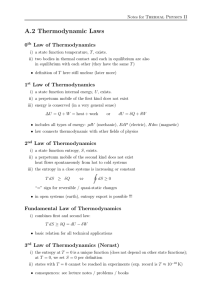
The Second law of Thermodynamics Seytkasymova Nurbakyt The second principle of thermodynamics The second principle of thermodynamics states that an isolated system moves spontaneously towards a maximum in its entropy. When this state is achieved, then the system is in thermodynamic equilibrium. In the same way, the decrease of the free energy down to a minimum can be considered as the way towards the equilibrium in the sense of the second principle. Any movement as a result of energy transformation leads to an increase in the entropy of the system or its environment. The term entropy production (σ = dS/dt) has been introduced to characterize this process. The entropy production is always positive, but can approach zero. The condition: σ = 0 would mean an idealized reversible process. Thermodynamically, a process is defined as being reversible if it can be repeated an arbitrary number of times without requiring the supply of additional energy. Some Fundamental Concepts of Thermodynamics To prevent misunderstanding, the different meanings of the term “reversible” in physics, chemistry, and biology must be pointed out. In physics, the term “reversible” is used according to the thermodynamic definition, i.e., connected with the above-mentioned condition: σ = 0. When a chemist speaks about a “reversible reaction,” or a “reversible electrode,” he only means processes that in principle could run in both directions, independently of the required energy. Finally, the biologist states that a change in a biological system is “reversible” when it is able to reverse an induced change so that no irreparable damage is caused (for example: reversible inhibition of metabolic processes). Let us consider the total entropy balance of a system. In closed systems, as a result of energy transformations, only an entropy increase is possible up to the point where the thermodynamic equilibrium is established without any further entropyproducing processes. In open systems, however, which are able to exchange not only energy but additionally matter, the entropy may change in both directions. An entropy decrease can occur if substances with low entropy content are incorporated, in exchange for entropy-rich substances that are being extruded. To characterize this process, an entropy flux (JS) is formulated which penetrates the whole system. Hence, the total entropy balance of the system can be written as follows: Energetics and Dynamics of Biological Systems Let us illustrate this statement with an example: Using radionuclides it is possible to demonstrate that human erythrocytes exchange chloride as well aspotassium ions with their environment. With this method, it is possible to measure directly the corresponding exchange rates. This kinetic method of analysis may give the impression that both ions, Cl, as well as + K, are in a steady state because in both cases the unidirectional fluxes, outside ! in and inside ! out, are equal. This, however, is an incorrect conclusion. The chloride ions in fact are distributed passively between the external medium and the cytoplasm, according to their thermodynamic equilibrium. Some Fundamental Concepts of Thermodynamics An important property of all stationary states is their kind of stability. Let us illustrate this by a mechanical example of a sphere on a surface (Fig. 3.5). The requirement for a stationary state, in this case this simply means an equilibrium, is the sphere coming to rest on any small, but horizontal part of the surface. In the case of an indifferent state, the surface is horizontal in general. In this case the energy of the sphere will not be changed by alteration of its position. In the case of a stable 114 3 Energetics and Dynamics of Biological Systems state, every change of the position leads to an increase of the energy of the sphere, and generates a force driving the sphere back to its original state. In contrast an unstable state is characterized by a situation where even small changes of the position release forces that cause the system to be deflected even more. Additionally sometimes so-called metastable states are considered. As metastable, a stable state can be considered which is delimitated from another one by a small barrier which can easily be overcome Figure 3.6 indicates all possible kinds of stationary states. First of all the presence, or the absence of entropy production indicates whether the given stationary state is a thermodynamic equilibrium (s ¼ 0), or whether it is a steady state (s > 0). In the case of thermodynamic equilibrium one must distinguish between global and local equilibria. In the case of a global equilibrium, the function of free energy indicates only one minimum. This means that no alteration, however strong it may be, can bring the system into another equilibrium state. An example is the equilibrium distribution of an ion between the cell and its environment. In contrast, in the case of the local equilibrium, the energetic function indicates two or more minima which are separated by more or less high energy barriers. As an example, isotherms of biochemical reactions can be considered, as illustrated in Fig. 2.5. The stability of such local equilibria is determined by the energy barrier between them. If this barrier is so low that thermal fluctuations can lead to quick transitions, the state is called metastable. This for example is the typical situation for enzymesubstrate complexes. For the schemes in Fig. 3.6 it must be considered that in reality G is not simply a function of a single reaction coordinate (x), but rather a hyperplane in ndimensional space Some authors discuss this metabolic rate in context with this Prigogine principle of minimal entropy production. Figure 3.7 shows for example a mean scheme of the characteristic situation in mice. While the total heat production (Q_) increases in accordance with their age and mass (m), the specific heat production, that is the heat production relative to the body weight, i.e., the dissipation function (F), reaches a maximum and then decreases. It seems therefore that an animal in the state of Fig. 3.6 Possible types of stationary states and conditions of their stability 116 3 Energetics and Dynamics of Biological Systems development increases entropy production, whereas an adult organism tends to arrive at a minimum. Disturbances in life lead to various deflections from this curve. If an organism for example is injured, if it is stressed by some environmental conditions, or in the case of tumor growth, the corresponding disturbances of the metabolism lead to a temporary increase in the slope of the curve. Figure 3.8 shows some characteristic times on a logarithmic scale that will serve to extend this list of examples.









